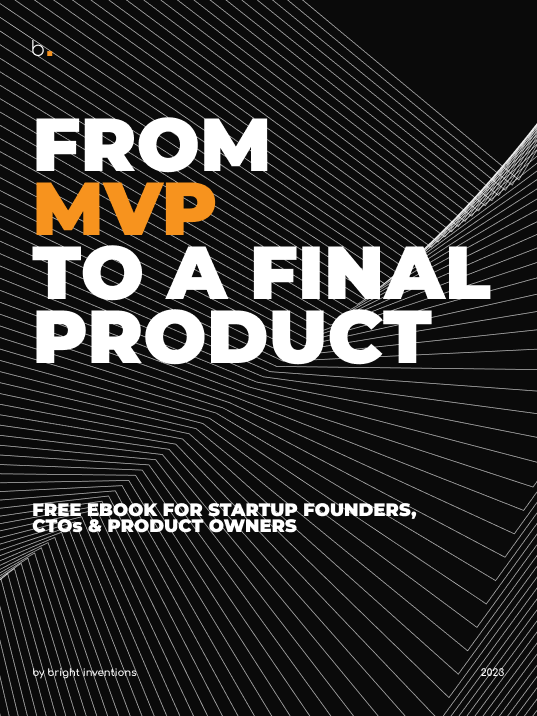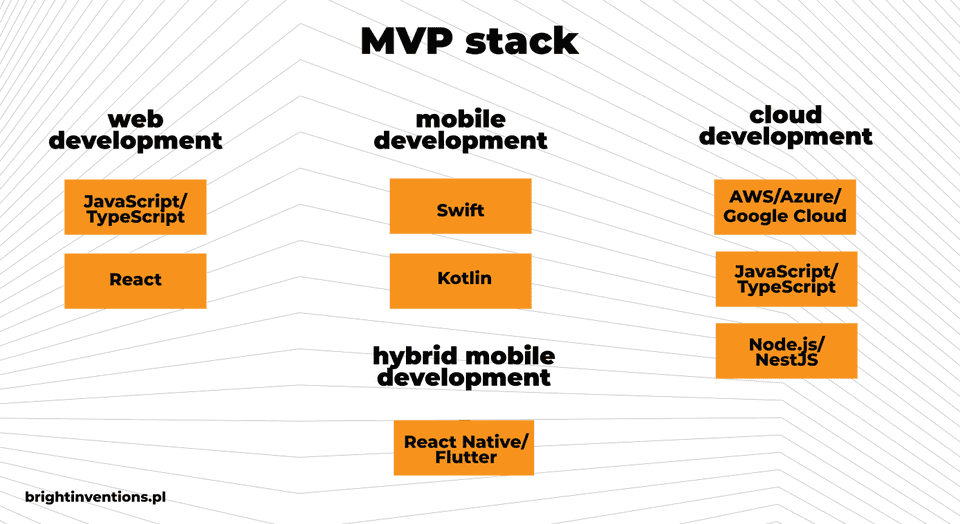Choosing MVP Tech Stack in 2025. What Startup Founder & CTO Should Know
Selecting a tech stack for your MVP should be a well-thought-out process. Every software product is different, so there isn’t one MVP stack cheat sheet for all of them. Let’s go through the most common decision-making factors while choosing technologies and languages for your digital product. Ultimately, check out the list of a typical tech stack for MVP in 2025.
More free MVP insights just for you

Table of contents
Choose only standardized software & tools
Choose a stack that your development team/MVP agency knows
Hybrid or native mobile app? That is the question…
Last but not least – mobile or Progressive Web App (PWA)?
Choose MVP stack wisely – book a free consultation
Choose only standardized software & tools
Think twice before you agree to develop your MVP using a niche framework or unpopular programming languages and libraries. It may be a sign of a couple of potential issues in the future.
One of the problems is moving the project to the in-house team or another software company. It will be challenging to find developers and software agencies that are familiar with unpopular stack. You would be forced to find experts with some very unpopular skills. That brings extra costs to the table.
What’s more, niche tools and solutions usually don’t have a community built around them, so there will be not enough materials and docs that would help developers to faster find solutions for tech issues. As a result, it might slow down the development process.
The easiest way to verify the popularity of languages and other tools is by reading the annual Stack Overflow Developer Survey. However, it doesn’t mean that you should just choose the most popular tools/languages on the market. Yet ensure that the stack you go with is well-known, with lots of resources and documentation that will support your developers.
Choose a stack that your development team/MVP agency knows
You shouldn't force a tech unknown to your team because it will slow down the MVP process and probably compromise the quality of the software they produce.
You should take developers' voices into account. They will be working with the stack you eventually approve, so they should have a chance to at least express their opinion and show you why they recommend one tool over another.
Don’t blindly follow trends. Choose the stack that suits your product
When you build an MVP from scratch, there is a huge temptation to use new trendy solutions. For example, Apple’s SwiftUI. It is a framework that simplifies work for iOS developers. Yet it cannot be used in every situation as explains Tomek Lizer, a Senior iOS Developer at Bright Inventions:
If it is a solution for a large group of users with a spectrum of Apple devices, then you can’t choose only Swift UI. No matter how trendy it is right now. Yet if the product targets a smaller group of tech-savvy users I would base it on Swift UI. Having in mind that it is still a young technology, you cannot cross off good old UIKit completely.
So remember to adjust trendy tools to your product and target group.
Hybrid or native mobile app? That is the question…

In terms of mobile development, you must first decide whether to build two separate native apps for iOS and Android or go for a cross-platform product. The latter means one mobile app dedicated to both app stores.
Hybrid apps are usually easier and faster to build and launch as MVPs. They might be the answer for startups with limited budgets. It can be a reasonable option if you want to launch the MVP and validate your idea quickly.
However, building a hybrid app means you add another layer to your code. Having also in mind that your app will never perform as well as the native one because you have to make compromises to meet "the expectations of both systems".
If you treat your MVP as a cornerstone of your solution, as we recommend, then in the long term, it might bring more problems than solutions to the table. However, as we said, every MVP is different, so native vs. hybrid app is a discussion every startup founder or CTO has to conduct. The outcome should come from a deep analysis of both sites.
It’s worth adding that you can always start with one app for one store. You don’t have to launch apps for iOS and Android at the same time. That is what Instagram or Clubhouse did. They launched their app first on AppStore.
Last but not least – mobile or Progressive Web App (PWA)?
Maybe you don’t need to start with a mobile app. There is a chance that at the beginning, you will only need a website that resembles a mobile application called Progressive Web App. PWA can run on any device with a web browser.
Although some features will be limited compared to mobile apps (e.g. Bluetooth, less accurate GSP, and no running in the background), PWA might be an option to consider. Especially for startup founders who want to build a simple solution accessible on many devices to quickly verify the idea’s potential.
MVP development stack 2025
We took into account many factors influencing decision-making. Now it’s time to list the most typical MVP stack in 2025.

Web Development Stack for your MVP
JavaScript/TypeScript, React
Nowadays, JavaScript is your first-to-go language. If your development team or agency uses TypeScript, that’s even better because it optimizes the coding process. However, JS and TS will be nothing without the framework.
There are several frameworks to consider: React, Node.js, Angular and more. React has traditionally been a primary choice for professional developers and remains a favorite. However, Node.js has gained significant ground in 2024. According to the Stack Overflow 2024 Survey, almost 42% of developers have recently worked with React, while nearly 41% have worked with Node.js, narrowing the gap considerably.
Mobile development stack for MVP
- Native app development: Swift (iOS), Kotlin (Android)
- Hybrid app development: React Native / Flutter
If you go with native app development, then you should use languages recommended by Apple or Android. Swift is used for iOS app development and Kotlin for Android.
If you opt for hybrid development, then you should decide between React Native or Flutter. The smartest way might be to choose the one that is more familiar to your development team or MVP agency.
Cloud development
Amazon Web Services (AWS) / Microsoft Azure / Google Cloud
These are the top 3 cloud providers in the cloud market right now. Choose the one that is best known by your development team or the MVP agency plan to hire. That’s probably going to be AWS because it is the most popular provider based on the StackOverflow Survey. Nearly 50% of professional developers use AWS.
Node.js, NestJS
Node.js is a backend technology that enables for example to build API that communicates with mobile or web. Nest.js is a framework for Node.js.
Choose MVP stack wisely
Selecting a programming tech stack is one of the most important decisions at the beginning of your tech startup journey. So do it wisely, with strong collaboration with your development team, whether it is an in-house team or a hired MVP development agency.
